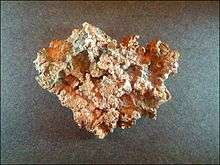Copper Country




The Copper Country is an area in the Upper Peninsula of Michigan in the United States, including all of Keweenaw County, Michigan and most of Houghton, Baraga and Ontonagon counties. The area is so named as copper mining was prevalent there from 1845 until the late 1960s, with one mine (the White Pine mine) continuing through 1995. In its heyday, the area was the world's greatest producer of copper.[1]
The Copper Country is highly unusual among copper-mining districts in that the copper was predominantly in the form of copper metal (native copper) rather than the copper oxides or copper sulfides that form the copper ore at almost every other copper-mining district. Native Americans mined copper from small pits as early as 3000 B.C.
The Michigan State Geologist Douglass Houghton (later to become mayor of Detroit) reported on the copper deposits in 1841. The first successful copper mine, the Cliff mine, began operations in 1845, and many others quickly followed. Mining of the most productive deposit, the Calumet conglomerate, began in 1865. Mining took place along a belt that stretched about 100 miles southwest to northeast.[2]
While mining continues on a small scale, tourism and logging are now the area's major industries. Popular tourist destinations include the cities of Copper Harbor and Houghton, and the Porcupine Mountains with Lake of the Clouds. Snowmobiling is very popular in the winter, and snowmobile trails are found in most areas.
Large numbers of Finns, Swedes, Danes, Sami and Norwegians emigrated to the Upper Peninsula, especially the Keweenaw Peninsula, to work in the mines. And they stayed on and prospered even after the copper mines closed.[3]
Ethnic groups that inhabited the area included: Chinese; Cornish; Croatians; Finns; French Canadians; Germans; Irish; Italians; Native Americans; Poles; and Slovenes.[1]
The Copper Country is largely rural, and much of it has been designated as state parks or similar designations. These include McLain State Park, Porcupine Mountains State Park, and the Copper Country State Forest. The Keweenaw National Historical Park includes several important sites relating to the area's copper-mining history.
Institutions of higher education include Finlandia University in Hancock, founded in 1896 as Suomi College, and Michigan Technological University in Houghton, originally established in 1885 as the Michigan School of Mines. Finlandia University is affiliated with the Evangelical Lutheran Church in America, reflecting the spiritual heritage of the region's many Finnish immigrants. Michigan Tech was founded in response to the needs of the copper mines.
The Copper Country averages more snowfall than any part of the USA east of the Mississippi River, and more snowfall than any non-mountainous region of the continental United States.[4]
See also
- Copper mining in Michigan
- Copper Island
- Keweenaw National Historical Park
- List of Copper Country mines
- List of Copper Country mills
- List of Copper Country smelters
References
- 1 2 An Interior Ellis Island: Ethnic Diversity and the Peopling of Michigan’s Copper Country, Keweenaw Ethnic Groups. MTU Archives and Copper Country Historical Collection, J. Robert Van Pelt Library, Michigan Technological University.
- ↑ Walter S. White (1968) The native-copper deposits of northern Michigan, in Ore Deposits of the United States, 1933-1967, New York: American Institute of Mining Engineers, v.1, p.303-325
- ↑ Simon, James and Finney, Patricia, Publication, Access and Preservation of Scandinavian Immigrant Press in North America, Center for Research Libraries, Quebec, Canada, August 10-14, 2008.
- ↑ "Mean Monthly and Annual Snowfall: Conterminous United States". Climate Source. Retrieved 10 June 2011.
Further reading
- Burt, Williams A., and Hubbard, Bela Reports on the Mineral Region of Lake Superior (Buffalo: L. Danforth, 1846), 113 pages.
- Carnahan, Arthur L., The Lake Superior Copper Country, National Magazine, December, 1905
- Harrison, Jim (November 30, 2013). "Imprint: My Upper Peninsula". The New York Times. Retrieved November 30, 2013.
- Thurner, Arthur W. Strangers and Sojourners - A History of Michigan's Keweenaw Peninsula (Detroit, Michigan, U.S.A.: Wayne State University Press, 1994) ISBN 0-8143-2396-0.
| Wikimedia Commons has media related to Minerals of Keweenaw County, Michigan. |
Coordinates: 46°56′N 88°48′W / 46.94°N 88.8°W